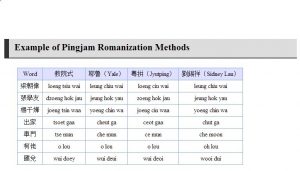When choosing the learning materials : Mind the Cantonese Romanization
Knowing the romanization of Cantonese surely help the learning.
What is romanization?
Putonghua (Mandarin used in China) has its romanization called “pinyin”.
There are several romanization system for Cantonese,
The lastest romanization system is Jyutping.
When you decide to buy some Cantonese learning material, you may come across with Yale, Sidney Lau, Jyutping system. They are similar to each other. If you start to learn Yale system in the beginning, you can also use books with Jyutping system. (What you may need is a comparison table for Yale and Jyutping) I can assure you it won’t be complicated.
I teach Cantonese, I have reference book on both system, it is not a big matter. The aim of having romanization is to help memorization of the pronunication, but never rely too much on them, a natural conversation never reply on romanisation, it is just naturally out of our brain and month, without the process of going to the romanisation. Therefore, treat the romanisation as a tool to help understand the phonetic system. We master the tone by listening, it comes easier and more naturally.


Leave a Reply